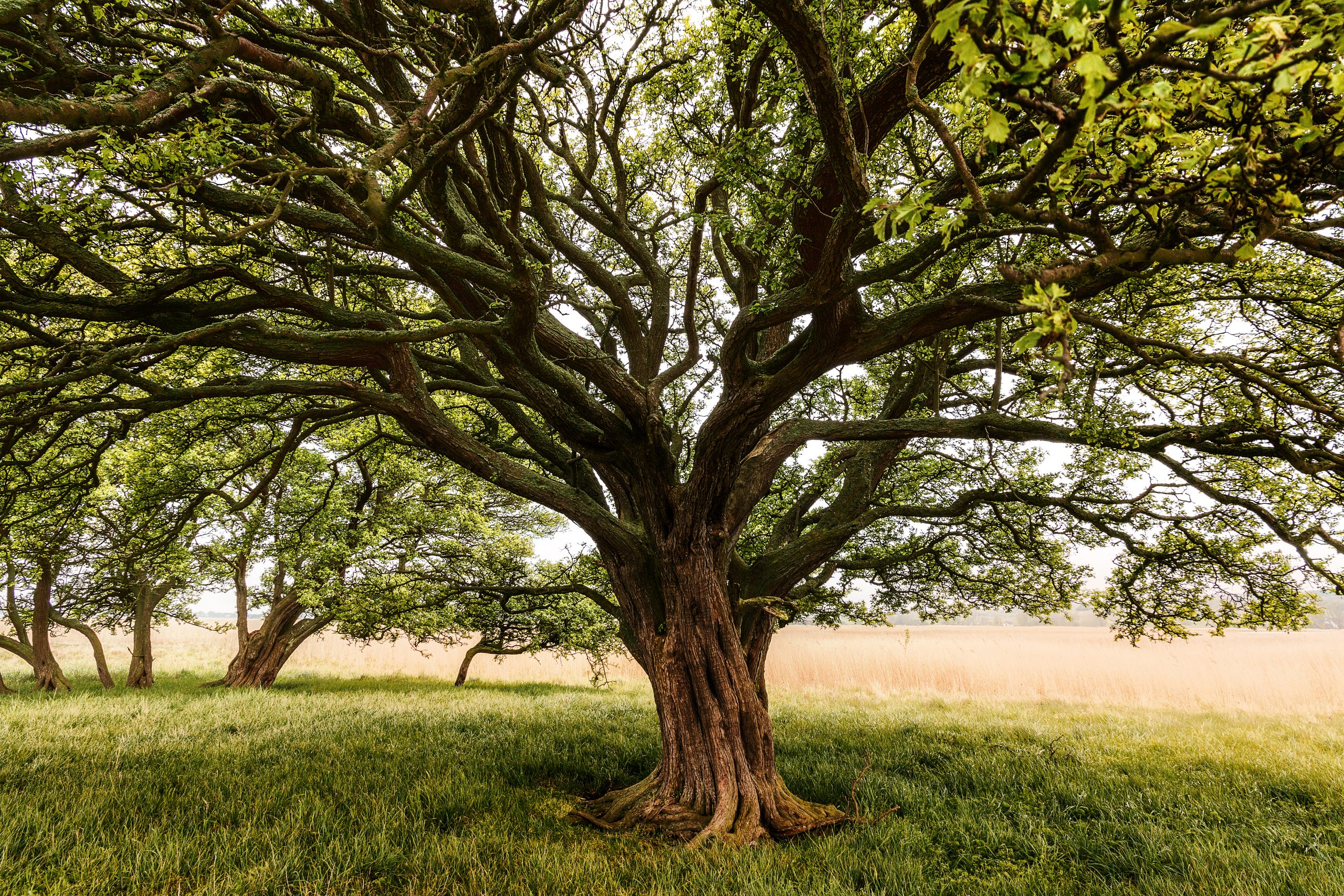ENCOURAGING BIODIVERSITY WITH TREE PLANTING
ENCOURAGING BIODIVERSITY WITH TREE PLANTING
Biodiversity, short for “biological diversity,” refers to the variety and variability of life forms on Earth, encompassing the diversity of species, ecosystems, and genetic material within them. It is a fundamental aspect of our planet’s health and resilience, playing a crucial role in maintaining the balance of ecosystems and supporting the well-being of all living organisms. Biodiversity encompasses both the complexity of life and the intricate interactions between different species and their environments.

Biodiversity can be understood at multiple levels:
- Species Diversity: Species diversity refers to the variety of different species within a specific area or ecosystem. It includes both the number of species present and their relative abundance.
- Genetic Diversity: Genetic diversity encompasses the variety of genetic traits and variations within a single species. It is vital for the adaptation and evolution of species over time, allowing them to respond to changing environmental conditions.
- Ecosystem Diversity: Ecosystem diversity pertains to the variety of different ecosystems, habitats, and ecological communities within a region. Each ecosystem has its unique combination of species and environmental characteristics.
Biodiversity is not only important for the natural world but also has profound implications for human society:
- Ecosystem Services: Biodiversity provides a wide range of ecosystem services that benefit humans. These services include pollination of crops, water purification, climate regulation, nutrient cycling, and more.
- Medicine and Biotechnology: Many pharmaceuticals and medical treatments are derived from natural sources, highlighting the potential of biodiversity in advancing medical research and biotechnology.
- Food Security: Biodiverse ecosystems provide a diverse range of foods, supporting global food security by offering a variety of crops, livestock, and aquatic species.
- Cultural and Aesthetic Value: Biodiversity is intertwined with cultural practices, traditions, and spiritual beliefs of many communities. It also contributes to the aesthetic beauty and recreational value of landscapes.
- Resilience and Adaptation: Biodiversity enhances the resilience of ecosystems and species in the face of environmental changes, including climate change and natural disasters.
- Ecological Balance: The intricate interactions between species within ecosystems help maintain ecological balance. Loss of biodiversity can disrupt these interactions, leading to ecological imbalances and negative consequences.
- Scientific Understanding: Biodiversity is a rich source of scientific knowledge, shedding light on evolutionary processes, ecological relationships, and the interconnectedness of life on Earth.
Conserving and protecting biodiversity is crucial to safeguarding the planet’s health and ensuring a sustainable future for both human societies and the natural world. Activities such as habitat destruction, pollution, climate change, and overexploitation of resources can threaten biodiversity. Therefore, efforts to preserve and restore biodiversity are vital for maintaining the intricate web of life that sustains our planet.
Importance of Biodiversity
The importance of biodiversity cannot be overstated, as it underpins the health, stability, and functionality of ecosystems, and has far-reaching implications for human well-being, economic prosperity, and the overall health of our planet. Biodiversity plays a vital role in various aspects of our lives and the environment:

- Ecosystem Stability and Resilience: Biodiverse ecosystems are more resilient to environmental changes, such as climate fluctuations and natural disasters. A diverse array of species ensures that if one species is affected by a disturbance, others may still perform essential ecological functions.
- Ecosystem Services: Biodiversity provides a multitude of ecosystem services that are vital for human survival and well-being. These services include pollination of crops, water purification, soil fertility, air quality regulation, climate regulation, and nutrient cycling.
- Food Security: Biodiversity is critical for global food security. A diverse range of plant and animal species provides a variety of foods, including crops, livestock, and seafood. Agricultural biodiversity increases resilience against crop diseases and pests.
- Medicine and Biotechnology: Many pharmaceuticals and medical treatments are derived from natural sources, particularly plants and microorganisms. Biodiversity is a rich source of potential discoveries that can lead to medical advancements.
- Cultural and Aesthetic Value: Biodiversity is intertwined with cultural practices, traditional knowledge, and spiritual beliefs of many communities around the world. Additionally, natural landscapes and diverse species contribute to the aesthetic beauty of our planet.
- Climate Change Mitigation: Healthy ecosystems with diverse vegetation can sequester carbon dioxide and play a significant role in mitigating climate change. Forests, for instance, act as carbon sinks, helping to regulate the global climate.
- Ecological Balance and Pest Control: Biodiverse ecosystems often have natural predators and controls that keep populations of pests and disease vectors in check, reducing the need for chemical interventions.
- Soil Health and Nutrient Cycling: Biodiversity contributes to healthy soils through nutrient cycling, organic matter decomposition, and soil structure improvement. Healthy soils are essential for agricultural productivity and ecosystem health.
- Ecological Research and Scientific Knowledge: Biodiversity serves as a basis for scientific research, providing insights into evolutionary processes, ecological interactions, and the complex relationships within ecosystems.
- Economic Value and Livelihoods: Biodiversity supports various economic activities such as tourism, recreation, agriculture, fisheries, and forestry. Many livelihoods depend on the health of ecosystems and the species they harbor.
- Genetic Resources: Biodiversity contains a vast pool of genetic resources that can be used to develop more resilient and adaptable crops, livestock, and other organisms.
- Ethical and Moral Significance: Protecting and conserving biodiversity reflects our ethical responsibility to preserve the myriad forms of life with which we share the planet.
In essence, biodiversity is essential for the functioning of ecosystems, the provision of vital ecosystem services, and the sustainability of both natural and human systems. It is a shared global asset that requires responsible stewardship to ensure its preservation for current and future generations.
How Tree Planting Contributes To Biodiversity
Tree planting plays a significant role in enhancing biodiversity by creating and restoring habitats, supporting ecosystem functions, and providing resources for a variety of species. Here’s how tree planting contributes to biodiversity:
- Habitat Creation: Trees provide habitats for numerous species, including birds, insects, mammals, and microorganisms. Planting trees in various environments, such as forests, urban areas, wetlands, and grasslands, creates new habitats and expands existing ones.
- Shelter and Nesting Sites: Trees offer shelter and nesting sites for wildlife. Cavities in tree trunks, branches, and leaves provide safe spaces for animals to rest, breed, and raise their young.
- Food Sources: Trees produce fruits, nuts, seeds, and flowers that serve as food sources for many animals, including birds, squirrels, insects, and mammals. Planting a diverse range of tree species increases the availability of food resources.
- Supporting Pollinators: Flowering trees attract pollinators such as bees, butterflies, and birds. Pollinators play a critical role in plant reproduction and contribute to the health and diversity of ecosystems.
- Microhabitats and Microclimates: Trees create microhabitats within their branches, trunks, and root systems. These microhabitats provide niches for various species, including epiphytes, mosses, and fungi.
- Biodiversity Corridors: Trees planted along natural corridors, such as riverbanks and wildlife corridors, facilitate the movement of animals and enable gene flow between fragmented habitats. This connectivity supports biodiversity by preventing isolation of populations.
- Erosion Control and Soil Health: Tree planting helps prevent soil erosion, stabilizing the land and protecting aquatic habitats from sedimentation. Healthy soils support diverse plant and microbial communities.
- Carbon Sequestration and Climate Regulation: Trees act as carbon sinks, absorbing carbon dioxide from the atmosphere. Forests and tree plantations contribute to mitigating climate change and supporting the health of ecosystems.
- Enhancing Ecosystem Services: Biodiversity contributes to various ecosystem services such as nutrient cycling, water purification, and soil health. Trees play a role in enhancing these services by providing diverse vegetation cover.
- Restoring Degraded Ecosystems: Tree planting can aid in the restoration of degraded ecosystems, such as deforested areas or former industrial sites. Restoring these ecosystems helps reintroduce native species and promotes biodiversity recovery.
- Education and Awareness: Tree planting initiatives raise awareness about the importance of biodiversity and encourage community engagement in conservation efforts.
- Genetic Diversity: Planting diverse tree species enhances genetic diversity within ecosystems, ensuring that a variety of traits are available for adaptation to changing environmental conditions.
By selecting appropriate tree species, promoting native vegetation, and considering the ecological context, tree planting projects can effectively contribute to the conservation and enhancement of biodiversity at local, regional, and global scales.
The Role of Trees in Biodiversity Conservation
Trees play a crucial role in biodiversity conservation, as they provide habitats, resources, and ecosystem services that support a wide range of species and contribute to the overall health and balance of ecosystems. Here’s how trees contribute to biodiversity conservation:

- Habitat Creation and Support: Trees provide habitats for a diverse array of species, from birds and insects to mammals and fungi. Their trunks, branches, leaves, and root systems create niches and shelter that various organisms can utilize for breeding, nesting, feeding, and protection.
- Keystone Species and Ecosystem Engineers: Some tree species act as keystone species or ecosystem engineers, influencing the structure and composition of entire ecosystems. For example, certain tree species can shape the physical environment, influence water availability, or provide resources that sustain other species.
- Food Sources: Trees produce fruits, nuts, seeds, and flowers that serve as food sources for a wide range of wildlife, including animals and insects. These resources contribute to the diet and survival of various species, supporting their populations.
- Corridor and Connectivity: Trees, especially when planted strategically, create corridors that connect fragmented habitats. These corridors enable animals to move between areas, maintain genetic diversity, and support the health of isolated populations.
- Supporting Pollinators: Many trees produce flowers that attract pollinators, such as bees, butterflies, and birds. These pollinators facilitate plant reproduction and contribute to the biodiversity of both flora and fauna.
- Microhabitats and Biodiversity Hotspots: Trees create microhabitats within their structures, offering refuge for diverse organisms like insects, fungi, and epiphytes. These microhabitats contribute to local biodiversity hotspots within larger ecosystems.
- Soil Health and Nutrient Cycling: Trees enhance soil health by stabilizing soil, preventing erosion, and improving soil structure. Their fallen leaves and organic matter contribute to nutrient cycling and provide resources for soil-dwelling organisms.
- Carbon Sequestration and Climate Regulation: Trees help mitigate climate change by sequestering carbon dioxide through photosynthesis. Forests and woodlands act as carbon sinks, reducing atmospheric carbon levels and regulating global climate patterns.
- Restoration of Degraded Ecosystems: Trees play a vital role in restoring degraded ecosystems. By reintroducing native tree species, degraded areas can recover their original biodiversity and ecosystem functionality.
- Ecological Resilience: Biodiverse ecosystems with a variety of tree species are often more resilient to disturbances and environmental changes. A diverse tree population can prevent the dominance of a single species and reduce the risk of catastrophic events.
- Supporting Indigenous and Traditional Knowledge: Trees hold cultural significance for many indigenous and local communities, and their preservation supports traditional knowledge and practices related to biodiversity conservation.
In summary, trees are foundational to biodiversity conservation due to their capacity to create habitats, provide resources, and offer essential ecosystem services. Incorporating trees into conservation efforts is crucial for maintaining the web of life on Earth and ensuring the sustainability of ecosystems for future generations.
About Murray, Utah
Murray is a city situated on the Wasatch Front in the core of Salt Lake Valley in the U.S. state of Utah. Named for territorial governor Eli Murray, it is the state's fourteenth largest city. According to the 2020 census, Murray had a population of 50,637. Murray shares borders with Taylorsville, Holladay, South Salt Lake and West Jordan, Utah. Once teeming with heavy industry, Murray's industrial sector now has little trace and has been replaced by major mercantile sectors. Known for its central location in Salt Lake County, Murray has been called the Hub of Salt Lake County. Unlike most of its neighboring communities, Murray operates its own police, fire, power, water, library, and parks and recreation departments and has its own school district. While maintaining many of its own services, Murray has one of the lowest city tax rates in the state.
Neighborhoods in Murray, Utah
Murray Oakes, Grant Park, Southwood Park, Murray Park, Murray Park Restrooms, Willow Pond Park, Neighborhood Veterinary Care
Things To Do in Murray, Utah
Bus Stops in Murray, Utah to Truco Services, Inc.
Bus Stop in Murray Central Station (Bay C) Murray, Utah to Truco Services, Inc.
Bus Stop in State St @ 4801 S Murray, Utah to Truco Services, Inc.
Bus Stop in Murray North Station Murray, Utah to Truco Services, Inc.
Bus Stop in State St @ 4949 S Murray, Utah to Truco Services, Inc.
Bus Stop in Murray Central Frontrunner/Trax Station Murray, Utah to Truco Services, Inc.
Bus Stop in Murray Blvd / Vine St (SB) Murray, Utah to Truco Services, Inc.
Bus Stop in State St @ 3925 S Murray, Utah to Truco Services, Inc.
Bus Stop in State St @ 4824 S Murray, Utah to Truco Services, Inc.
Bus Stop in State St @ 5223 S Murray, Utah to Truco Services, Inc.
Bus Stop in Murray Blvd / Allendale Dr (NB) Murray, Utah to Truco Services, Inc.
Bus Stop in Murray Blvd @ 5039 S Murray, Utah to Truco Services, Inc.
Bus Stop in State St @ 4721 S Murray, Utah to Truco Services, Inc.
Driving Directions in Murray, Utah to Truco Services, Inc.
Driving Directions from Woodruff Tree Trimming and Removal to 4640 Commerce Dr, Murray, UT 84107, USA
Driving Directions from Reliable Tree Care to 4640 Commerce Dr, Murray, UT 84107, USA
Driving Directions from Tree Pro-Tech to 4640 Commerce Dr, Murray, UT 84107, USA
Driving Directions from Prestige Tree And Landscape to 4640 Commerce Dr, Murray, UT 84107, USA
Driving Directions from Excellence Tree & Landscape to 4640 Commerce Dr, Murray, UT 84107, USA
Driving Directions from Amen Trees to 4640 Commerce Dr, Murray, UT 84107, USA
Driving Directions from Tim's Tree Care to 4640 Commerce Dr, Murray, UT 84107, USA
Driving Directions from Jordan Tree Service - Murray to 4640 Commerce Dr, Murray, UT 84107, USA
Driving Directions from Arbor Works to 4640 Commerce Dr, Murray, UT 84107, USA
Driving Directions from Diamond Tree Experts to 4640 Commerce Dr, Murray, UT 84107, USA
Driving Directions from Green Tree Arborist to 4640 Commerce Dr, Murray, UT 84107, USA
Driving Directions from TruCo Services to 4640 Commerce Dr, Murray, UT 84107, USA
Reviews for Truco Services, Inc. Murray, Utah
Emily Abercrombie
We had a great experience with TruCo! They were well priced, responsive and prompt. Michael was a pleasure to work with and gave us advice on which plants to put in where we took out our ugly old shrubs. I would highly recommend this company!!!
Michelle Turpin
TruCo Services gets 5 stars from us for customer service. We experienced a few issues with their services this last year and Rob Eccles in senior management, stepped in and immediately handled our issues. He was very committed to making sure they understood our expectations and would execute to make us happy.
Siobhan Billingsley
I work for a property management company and have the pleasure of working with Rob at a community in Sandy. He has been incredible to work with and always responds in a timely manner. He knows all the homeowners by name and address and is aware of all the "problem" areas when it comes to sprinklers. I never have to worry about following up with him because he always reaches out to provide me with an update. If you're looking to work with someone who takes pride in their job, is professional, and can solve the worst landscaping problems thrown your way, Rob is your guy. Thank you, Rob for all you do!
Jaime S.
We have used Truco at 2 of the complexes we manage, they have been great to work with. Good quality service, outstanding customer service with good communication. That's hard to find these days. I highly recommend them. Travis has been awesome to work with.
Jerusha Smart
We use TruCo for a majority of our properties and our home. While other landscaping companies we use come and go for various reasons like cost, communication issues, work performance, etc., TruCo is always consistent in price and work. Also, Rob is the best.


